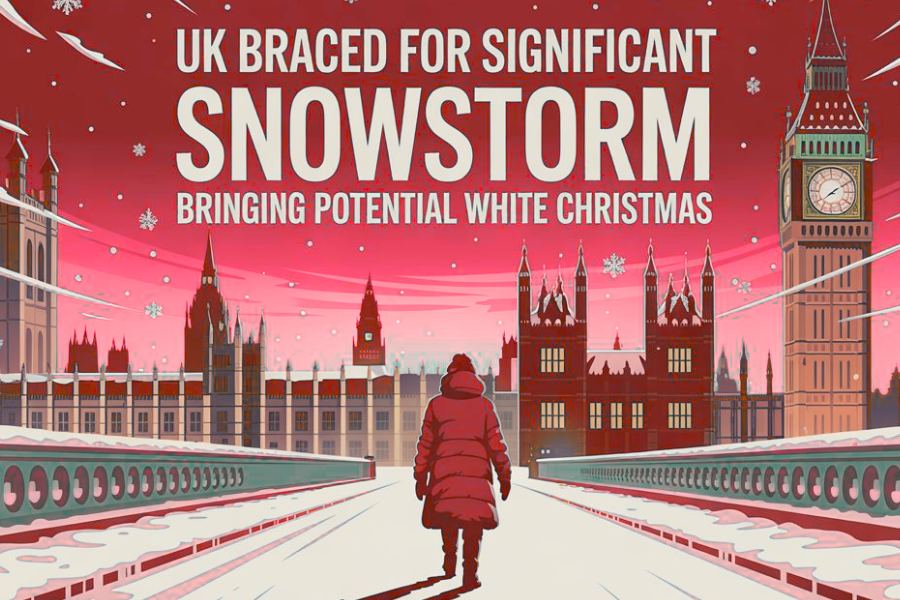Introduction
The United Kingdom is preparing for what meteorologists describe as one of the most significant snow events in recent years. With a major snowstorm predicted to sweep across the country in the coming weeks, public attention has turned to the rising possibility of an authentic white Christmas. While the idea of snow-covered rooftops and festive winter landscapes excites many, the practical implications of severe winter weather are far more complex. Heavy snow can disrupt transportation, strain energy systems, impact the economy, and challenge everyday life. This detailed report explores the science behind the forecast, the regions most at risk, the likelihood of a white Christmas, and the steps individuals and authorities should take as the storm approaches.
Understanding the Snowstorm Risk in the UK
The UK’s geographical location places it between maritime Atlantic influences and northern Arctic air masses. This position creates highly changeable weather conditions, meaning that sudden shifts from mild rain to heavy snow are possible within short periods. Significant snowstorms usually occur when cold Arctic air descends southward and meets moisture-laden Atlantic systems—an atmospheric clash that produces widespread snowfall.
This winter, forecasters are observing an unusual alignment of meteorological factors. High-pressure systems forming over Greenland and Scandinavia are directing colder air towards the British Isles. At the same time, the jet stream—a fast-moving air current that guides weather fronts—has shifted southwards, opening a pathway for polar air to dominate the region. These conditions significantly increase the likelihood of prolonged cold spells and snowstorms across much of the UK.
While the UK does not experience the extreme winter conditions seen in countries like Canada or Russia, its infrastructure is also not built for heavy snowfall. Even moderate snow can cause substantial disruption, making early preparation essential.
Regions Most Likely to Be Affected
Snowfall in the UK varies greatly depending on elevation, geography, and proximity to the Atlantic Ocean. The coming snowstorm is expected to impact the following regions most severely:
Scotland
The Scottish Highlands, Grampian region, and higher areas around Aberdeen and Inverness are likely to receive the heaviest accumulation. These areas are traditionally more accustomed to snow, but the intensity expected this winter may still cause road closures and power issues.
Northern England
Counties such as Cumbria, Northumberland, Durham, and the Pennines may see significant snowfall. The combination of high elevation and exposure to cold air makes these places particularly vulnerable.
Wales
Snowdonia and mid-Wales often experience early and heavy snow due to their mountainous terrain. This year’s forecast suggests that central Wales could also face travel disruptions.
South West England
Typically mild due to Atlantic influences, the South West can experience heavy snow when cold inland temperatures meet moist maritime air. Areas such as Devon, Cornwall, and Exmoor may see surprise snowfall.
The Midlands and Home Counties
Although these areas normally experience lighter snow, significant winter systems can lead to widespread disruption due to densely populated towns and cities. Even small amounts of snow in these areas can result in blocked roads and delays.
London and the South East
London tends to avoid heavy accumulation, but even moderate snowfall can affect public transport, especially rail and bus services. The high population density amplifies the impact of even minor weather events.
Weather Alerts & Forecasting Models
The UK Met Office and global meteorological agencies rely on advanced prediction models to track and estimate snowstorm conditions. Among the key systems in use:
- ECMWF (European Model): Known for long-range accuracy, currently showing strong signals of cold air dominance.
- UKV (Met Office Model): Offers precise, short-term forecasts, particularly useful in predicting snow impact on specific regions.
- GFS (American Model): Provides quick updates and is widely used for identifying developing weather trends.
Early yellow and amber warnings have already been issued for Scotland and the northern regions of England. These alerts highlight risks of icy roads, reduced visibility, and potential power outages. As the storm approaches, more localized warnings will likely follow.
Will the UK Have a White Christmas?
A white Christmas in the UK is defined by the Met Office as a single snowflake falling on December 25 at designated observation points. While snow often falls in December, it is surprisingly rare for it to occur on Christmas Day itself.
This year, however, the probability is higher than usual:
- Northern UK: 40–50% chance
- Midlands and Wales: 30–40% chance
- Southern England including London: 20–30% chance
These percentages represent a significant increase over typical winter averages. Whether it officially counts as a white Christmas will depend on observation data recorded on December 25.
The Meteorology Behind the Snowstorm
Three key scientific factors underlie the forecast:
1. Blocking High Pressure
Strong high-pressure systems over Greenland and Iceland block warm Atlantic air, pushing the jet stream southward. This allows Arctic air to sweep into the UK.
2. Jet Stream Shift
A deeper, southward jet stream dip brings cold polar air and supports the development of low-pressure systems that generate snow.
3. Ground Temperature Cooling
Clear winter nights enable frost and ice to accumulate. When snow falls onto already frozen ground, it settles more easily and remains longer.
This combination of atmospheric conditions is particularly potent and increases the risk of heavy snowfall.
Travel and Transportation Disruptions
The UK is particularly vulnerable to winter travel disruptions. During past snowstorms, chaos occurred across:
Roads
- Motorway closures
- Traffic accidents
- Delays due to ice and poor visibility
Railways
- Frozen points and broken overhead lines
- Limited rural routes
- Major delays on commuter networks
Airports
- Runway closures
- Flight delays and cancellations
- Safety restrictions on aircraft de-icing
Authorities advise travelers to plan ahead, check forecasts regularly, and prepare emergency kits for road journeys.
Impact on Homes, Heating, and Energy Supply
Heavy snowfall significantly increases national energy demand. Homeowners may face:
- Frozen pipes
- Heating system failures
- Higher energy bills
- Roof damage from excess snow
- Potential power outages
The National Grid is preparing for peak demand, while energy companies are urging residents to insulate pipes and service heating systems to avoid emergencies.
Economic and Insurance Implications
Snowstorms bring a range of economic challenges, including:
- Reduced workforce availability
- Decline in retail footfall—especially critical before Christmas
- Increased costs for councils and emergency services
- Insurance claims related to burst pipes, accidents, or property damage
- Disruptions to supply chains and deliveries
Tourism and holiday travel may also take a hit if conditions worsen.
School Closures and Remote Work Preparedness
Schools in rural or elevated areas may close temporarily due to unsafe conditions. Many education authorities now have online learning platforms ready to use when required.
Companies across the UK are also preparing for increased remote work. Following the pandemic, most businesses are now better equipped to handle weather-related disruptions.
Public Response and Community Preparedness
Snowstorms, despite their challenges, often bring communities together. Volunteers help clear paths, check on elderly neighbors, and deliver essentials to isolated households. Many families enjoy winter activities, contributing to a festive atmosphere. However, safety remains a priority, and authorities continue to warn residents to stay vigilant and follow official guidance.
Final Thoughts
As the UK Braced for Significant Snowstorm Bringing Potential White Christmas, the nation finds itself balancing the seasonal excitement of a white Christmas with the practical challenges of winter weather. While many look forward to picturesque snowy landscapes, the impacts on travel, energy, infrastructure, and daily life cannot be overlooked. Preparation, timely information, and community cooperation will be key in navigating the coming weeks. Whether this Christmas turns white or not, the situation highlights the importance of resilience and readiness during winter weather events.



